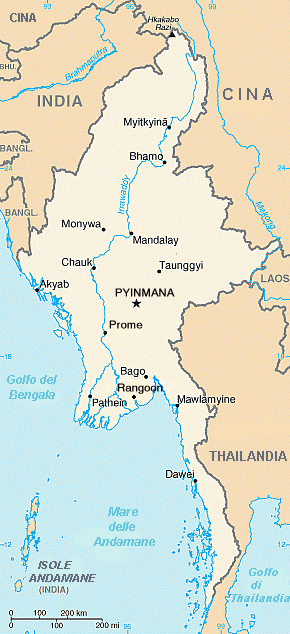Myanmar English
| Burmese English | |
|---|---|
| Myanmar English | |
| အင်္ဂလိပ်, Myanmar English | |
 A welcome sign in English in Myanmar. | |
| Pronunciation | bərˈmiz ˈɪŋ glɪʃ |
| Native to | Myanmar |
| Ethnicity | Burma |
Indo-European
| |
Early form | |
| Dialects | |
| Latin (English alphabet) | |
| Language codes | |
| ISO 639-3 | – |
| IETF | en-MM |
 Myanmar | |
| Part of a series on the |
| English language |
|---|
| Topics |
| Advanced topics |
| Phonology |
| Dialects |
|
| Teaching |
Burmese English (also called Myanmar English) is the register of the English language used in Myanmar (Burma), spoken as first or second language by an estimated 2.4 million people, about 5% of the population (1997).[1] The English language was initially introduced to the country during the British colonial period, spanning from 1824 until independence in 1948.[2]
History
The
On 1 June 1950, a new education policy was implemented to replace English as the medium of instruction in all state schools, although universities, which continued to use English as the medium of instruction, were unaffected. English was taught as a second language from the Fifth Standard.[3] Until 1965, English was the language of instruction at Burmese universities.
In 1965, Burmese replaced English as the medium of instruction at the university level, with the passing of the New University Education Law the previous year.[4] English language education was reintroduced in 1982. Currently, English is taught from Standard 0 (kindergarten), as a second language. Since 1991, in the 9th and 10th Standards, English and Burmese have both been used as the medium of instruction, particularly in science and math subjects, which use English-language textbooks.[3] Because of this, many Burmese are better able to communicate in written English than in spoken English, due to the emphasis placed on writing and reading.
Characteristics
Orthography
The preferred system of spelling is based on that of the British, although American English spellings have become increasingly popular. Because Adoniram Judson, an American, created the first Burmese-English dictionary, many American English spellings are common (e.g. color, check, encyclopedia).[5] The ⟨-ize⟩ spelling is more commonly used than the ⟨-ise⟩ spelling.
Vocabulary
Burmese English is often characterised by its unaspirated consonants, similar to Indian English. It also borrows words from standard English and uses them in a slightly different context. For instance, "pavement" (British English) or "sidewalk" (US English) is commonly called "platform" in Burmese English. "Stage show" is also preferred over "concert."
For units of measurement Burmese English use both those of the
The
Honorifics
Burmese names represented in English often include various honorifics, most commonly "U", "Daw", and "Sayadaw". For older Burmese who only have one or two syllables in their names these honorifics may be an integral part of the name.
Pronunciation
In Burmese English, the k, p, and t consonants are unaspirated (pronounced /k/, /p/, /t/), as a general rule, as in Indian English. The following are commonly seen pronunciation differences between Standard English and Burmese English:[6][7]
| Standard English | Burmese English | Remarks |
|---|---|---|
| /ɜːr/ (e.g. further, Burma) | /á/ | Pronounced with a high tone (drawn-out vowel), as in Burmese |
| Word-final /aʊ/ (e.g. now, brow) | /áuɴ/ | Pronounced with a nasal final instead of an open vowel |
| Word-final /aɪ/ (e.g. pie, lie) | /aiɴ/ | Pronounced with a nasal final instead of an open vowel |
| /tjuː/ (e.g. tuba) | /tɕu/ | e.g. "tuition," commonly pronounced [tɕùʃìɴ] |
| /sk/ (e.g. ski) | /sək-/ | Pronounced as 2 syllables |
| /st/ (e.g. star) | /sət-/ | Pronounced as 2 syllables |
| /pl/ (e.g. plug) | /pəl/ | Pronounced as 2 syllables |
| /sp/ (e.g. spoon) | /səp/ | Pronounced as 2 syllables |
| /v/ (e.g. vine) | /b/ | |
| /ŋk/ (e.g. think) | /ḭɴ/ | Pronounced with a short, creaky tone (short vowel) |
| /ŋ/ (e.g. thing) | /iɴ/ | Pronounced as a nasal final |
| consonantal finals (.e.g. stop) | /-ʔ/ | Pronounced as a glottal stop (as in written Burmese, where consonantal finals are pronounced as a stop) |
In addition, many words retain British pronunciation, such as vitamin
References
- S2CID 27734149.
- ^ "Language Choice in Higher Education: Challenges and Opportunities" (PDF). British Academy. 14 February 2015.
- ^ a b Thein Lwin (2000). Education in Burma (1945-2000) (PDF) (Report). Migrant Learning Centre. Archived from the original (PDF) on 2011-04-30. Retrieved 2010-08-21.
- ISBN 978-981-230-211-3.
- OL 6459075M.
- ^ Barron, Sandy; John Okell; Saw Myat Yin; Kenneth VanBik; Arthur Swain; Emma Larkin; Anna J. Allott; Kirsten Ewers (2007). Refugees From Burma: Their Backgrounds and Refugee Experiences (PDF) (Report). Center for Applied Linguistics. Archived from the original (PDF) on 2011-04-27. Retrieved 2010-08-20.
- ^ Than Than Win (2003). "Burmese English Accent" (PDF). Papers from the Seventh Annual Meeting of the Southeast Asian Linguistics. Arizona State University, Program for Southeast Asian Studies: 225–241.
